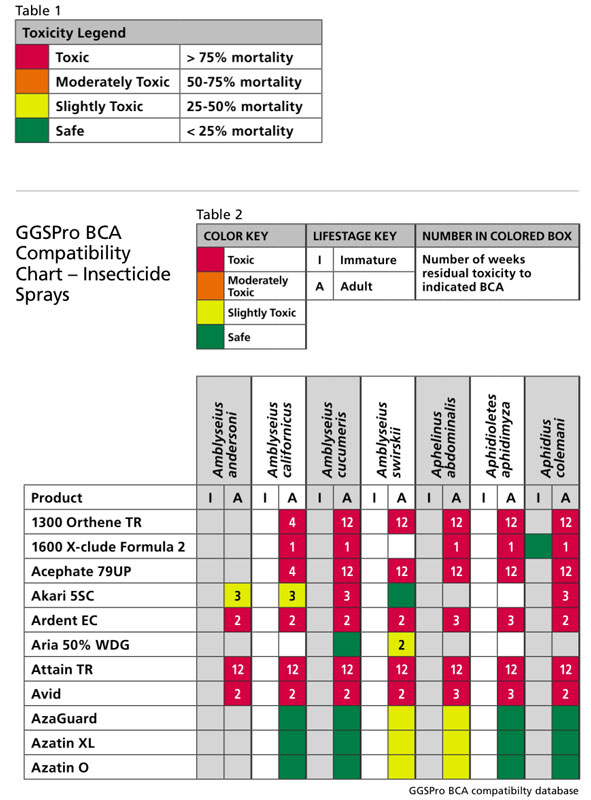4/1/2018
Biocontrol Programs & Pesticides: A Place for Both?
Rick Yates

Growers who are committed to biocontrol programs utilizing BCAs (biological control agents) have typically made a conscious decision to reduce or eliminate pesticide usage, so why even consider integrating pesticides? Integrated pest management (IPM) includes a variety of tactics that interact with each other. This includes, on occasion, beneficial insects, nematodes and/or mites in use with certain pesticides. Some possible scenarios include:
• A rapid change from cool to warm conditions causes the pest population to reproduce faster than the predators. This often happens with aphids in the spring, when the weather suddenly breaks.
• Unanticipated BCA shortages in the middle of a biocontrol program can threaten the success of the control efforts. The biocontrol companies generally do a very good job, but shortages still occur. A few years ago, a volcanic eruption in Iceland stopped shipping from Europe for a period of time!
• Incoming plant material sometimes arrives with a higher pest population than is acceptable to begin a biocontrol program. Pesticides with short residual activity may be required to clean up before releasing BCAs.
Biocontrol programs take time to design and execute properly. The ability to apply a compatible pesticide to combat a hot spot or surge in pest activity may help preserve a program that’s already well underway. One key to success is the ability to determine which pesticide(s) are suitable, taking into account which BCAs are in use. Some good sources for this information include biocontrol companies, university/extension research and pesticide companies. There’s safety in utilizing multiple sources whenever possible, as there isn’t always full agreement.
The term “compatible pesticides” needs some explanation. In Table 1, you can see that even “safe” pesticides might cause up to 25% mortality to the particular BCA in use. However, mortality isn’t the only consideration. Sub-lethal effects may include repellency that influences the ability of parasitoid or predator to locate the pest. Residues from the pesticide on the host may make them unacceptable to the BCAs.*
Other significant sub-lethal effects may include reduced ability to forage for hosts, sterilizing females and reduced egg laying. All things considered, compatible pesticides need to be used with caution and only when other reasonable options have been exhausted. Continued research in this area will yield better decision-making information for
growers.
Toxicity isn’t the only consideration when evaluating pesticides for suitability within a biocontrol program. We must also consider the length of time in which a pesticide produces negative effects. Pesticides based on soaps and oils may have very short residual side effects, a week or less in some cases. Synthetic pyrethroids (e.g., Decathlon, Talstar), organophosphates (e.g., Acephate, Duraguard) and carbamates (e.g., Mesurol, Sevin) can negatively impact BCAs for eight weeks or longer. Applying one of these pesticides may end a biocontrol program for the entire season! Better to “measure twice and cut once,” as the carpenters say.
The need to carefully evaluate pesticides for use in biocontrol programs is driven home by some of the misconceptions growers may have about BCA safety. It might seem logical to assume that pesticides classified as bio-rational or organic would have good compatibility with BCAs. While that’s sometimes the case, all too often it’s not. OMRI-listed organic pesticides—such as the neem-based IGRs, M-Pede insecticidal soap, horticultural oils and fungicides like Milstop and Zerotol—all have some detrimental effects on one or more BCAs. That doesn’t mean they can never be used in a biocontrol program, but it does mean the negative effects need to be understood and accounted for. Growers are sometimes surprised to learn that some plant growth regulators and surfactants can also have unexpected negative effects on BCAs.
I encourage BCA users to identify compatible pesticide options well in advance; don’t wait until the biocontrol program is threatened to start researching options! The ability to react quickly may mean the difference between salvaging the program and losing control of the pest population. This is planning to succeed, not planning to fail. GT
*Adapted from: “Compatibility Conflict: Is the Use of Biological Control Agents with Pesticides a Viable Management Strategy?” by Dr. Raymond Cloyd, Kansas State University.
Rick Yates is GGSPro Technical Support Manager for Griffin. He can be reached at ggsprotech@griffinmail.com.